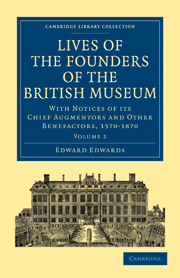 Lives of the Founders of the British Museum
Lives of the Founders of the British Museum BOOK THE THIRD: LATER AUGMENTORS AND BENEFACTORS. 1829–1870
Published online by Cambridge University Press: 05 August 2011
Summary
‘The comprehensive character of the British Museum–the origin of which may be traced to the heterogeneous nature of Sir Hans Sloane's bequest–doubtless makes it difficult to provide for the expansion of its various branches, according to their relative demands upon the space and light which can be applied to their accommodation. Any attempt, however, now to diminish that difficulty by segregating any portion, or by scattering in various localities the components of the vast aggregate, would involve a sacrifice of great scientific advantages which are not the less inherent in their union because that union was, in its origin, fortuitous. .…
‘Some passages of our evidence … illustrate the difficulty of drawing a line of separation, for purposes of management and superintendence, between certain Collections. .… Its occurrence [i.e. the occurrence of such a difficulty] indicates strongly the value to Science, of the accidents which have placed in near juxtaposition the Collections of mineralogy [and] of forms of existing and extinct animal and vegetable life. The immediate connexion of all alike with the Library of the Museum is too important to allow us to contemplate its dissolution.’–Report of the Commissioners appointed to inquire into the Constitution and Management of the British Museum (1850), p. 36.
- Type
- Chapter
- Information
- Lives of the Founders of the British MuseumWith Notices of its Chief Augmentors and Other Benefactors, 1570–1870, pp. 511 - 514Publisher: Cambridge University PressPrint publication year: 2010First published in: 1870
